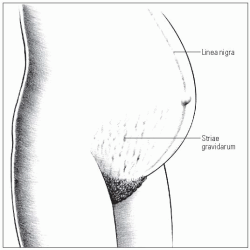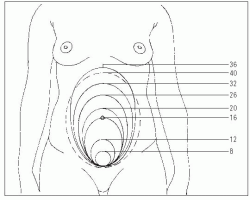Pregnancy produces several types of physiologic changes that must be evaluated before a definitive diagnosis of pregnancy is made. The changes can be:
Presumptive signs of pregnancy
Presumptive signs of pregnancy are those that can be assumed to indicate pregnancy until more concrete signs develop. These signs include breast changes, nausea and vomiting, amenorrhea, urinary frequency, fatigue, uterine enlargement, quickening, and skin changes. A pregnant patient typically reports some presumptive signs.
Breast changes
Tingling, tender, or swollen breasts can occur as early as a few days after conception. The areola may darken and tiny glands around the nipple, called Montgomery tubercles, may become elevated.
Nausea and vomiting
At least 50% of pregnant women experience nausea and vomiting early in pregnancy (commonly called morning sickness). These symptoms are typically the first sensations experienced during pregnancy. Nausea and vomiting usually begins at 4 to 6 weeks’ gestation. These symptoms usually stop at the end of the first trimester, but they may last slightly longer in some patients.
Amenorrhea
Amenorrhea is the cessation of menses. For a woman who has regular menses, this may be the first indication that she’s pregnant.
Urinary frequency
A pregnant woman may notice an increase in urinary frequency during the first 3 months of pregnancy. This symptom continues until the uterus rises out of the pelvis and relieves pressure on the bladder.
When lightening strikes
Urinary frequency may return at the end of pregnancy as lightening occurs (the fetal head exerts renewed pressure on the bladder).
Fatigue
A pregnant woman may report that she’s often fatigued. During the first trimester, the woman’s body works hard to manufacture the placenta and to adjust to the many other physical demands of pregnancy while she mentally and emotionally prepares for motherhood. Around 16 weeks’ gestation, the body has adjusted to the pregnancy, the placenta’s development is complete, and the patient should start to have more energy.
Uterine enlargement
Softening of the uterus and fetal growth cause the uterus to enlarge and stretch the abdominal wall.
Quickening
Quickening is recognizable movements of the fetus. It can occur anywhere between the 14th and 26th weeks of pregnancy but typically is noticed between weeks 18 and 22.
Fluttering flutterflies
To the patient, quickening may feel like fluttering movements in her lower abdomen.
Skin changes
Numerous skin changes occur during pregnancy, including those listed here:
Linea nigra refers to a dark line that extends from the umbilicus or above to the mons pubis. In the primigravid patient, this line develops at
approximately the third month of pregnancy. In the multigravid patient, linea nigra typically appears before the third month. (See
Skin changes during pregnancy.)
Melasma, also known as chloasma or the “mask of pregnancy,” are darkened areas that may appear on the face, especially on the cheeks and across the nose. Melasma appears after the 16th week of pregnancy and gradually becomes more pronounced. After childbirth, it typically fades.
Striae gravidarum are red or pinkish streaks that appear on the sides of the abdominal wall and sometimes on the thighs.
Probable signs of pregnancy
Probable signs of pregnancy strongly suggest pregnancy. They’re more reliable indicators of pregnancy than presumptive signs, but they can also be explained by other medical conditions. Probable signs include positive laboratory tests, such as serum and urine tests; positive results on a home pregnancy test; Chadwick sign; Goodell sign; Hegar sign; sonographic evidence of a gestational sac; ballottement; and Braxton Hicks contractions.
Laboratory tests
Laboratory tests for pregnancy are used to detect the presence of human chorionic gonadotropin (hCG)—a hormone created by the chorionic villi of the placenta—in the urine or blood serum of the woman. Because hCG is produced by trophoblast cells— preplacental cells that wouldn’t be present in a nonpregnant woman—detection of hCG is considered a sign of pregnancy. Because laboratory tests for diagnosing pregnancy are accurate only 95% to 98% of the time, positive hCG results are considered probable rather than positive.
Looking for hCG in all the right places
Tests for hCG include radioimmunoassay, enzyme-linked immunosorbent assay, and radioreceptor assay. For these tests, hCG is measured in milli-international units (mIU). In pregnant women, trace amounts of hCG appear in the serum as early as 24 to 48 hours after implantation of the fertilized ovum. They reach a measurable level of about 50 mIU/ml between 7 and 9 days after conception. Levels peak at about 100 mIU/ml between the 60th and 80th days of gestation. After this point, the level declines. At term, hCG is barely detectable in serum or urine.
Home pregnancy tests
Home pregnancy tests, which are available over-the-counter, are 97% accurate when performed correctly. They’re convenient and easy to use, taking only 3 to 5 minutes to perform.
Dip stick
Here’s how the home pregnancy test works:
Most manufacturers suggest that a woman wait until the day of the missed menstrual period to test for pregnancy.
Chadwick sign
Chadwick sign is a bluish coloration of the mucous membranes of the cervix, vagina, and vulva. It can be observed at 6 to 8 weeks’ gestation by bimanual examination.
Goodell sign
Goodell sign is a softening of the cervix that occurs at 6 to 8 weeks’ gestation. The cervix of a nonpregnant woman typically has the same consistency as the tip of the nose; the cervix of a pregnant woman feels more like an earlobe.
Hegar sign
Hegar sign is a softening of the uterine isthmus that can be felt on bimanual examination at 6 to 8 weeks’ gestation. As pregnancy advances, the isthmus becomes part of the lower uterine segment. During labor, it expands further.
Ultrasonography
Ultrasonography, or sonographic evaluation, can detect probable and positive signs of pregnancy. At 4 to 6 weeks’ gestation, a characteristic ring indicating the gestational sac is visible on sonographic evaluation, making this a probable rather than a positive sign of pregnancy.
Ballottement
Ballottement is passive movement of the fetus. It can be identified at 16 to 18 weeks’ gestation.
Braxton Hicks contractions
Braxton Hicks contractions are uterine contractions that begin early in pregnancy and become more frequent after 28 weeks’ gestation. Typically, they result from normal uterine enlargement that occurs to accommodate the growing fetus. Sometimes, however, they may be caused by a uterine tumor.
Positive signs of pregnancy
Positive signs of pregnancy include sonographic evidence of the fetal outline, an audible fetal heart rate, and fetal movement that’s felt by the examiner. These signs confirm pregnancy because they can’t be attributed to other conditions.
Ultrasonography
Ultrasonography can confirm pregnancy by providing an image of the fetal outline, which can typically be seen by the 8th week. The fetal outline on the ultrasound is so clear that a crown to rump measurement can be made to establish gestational age. Fetal heart movement may be visualized as early as 7 weeks’ gestation.
Audible fetal heart rate
Fetal heart rate can be confirmed by auscultation or visualization during an ultrasound. Fetal heart sounds may be heard as early as the 10th to 12th week by Doppler ultrasonography.
Fetal movement
Even though the pregnant woman can feel fetal movement at a much earlier date (usually around 16 to 20 weeks), other people aren’t able to feel fetal movement until the 20th to 24th week. Obese patients may not feel fetal movement until later in pregnancy because of excess adipose tissue.
 Memory jogger
Memory jogger Education edge
Education edge Advice from the experts
Advice from the experts
















